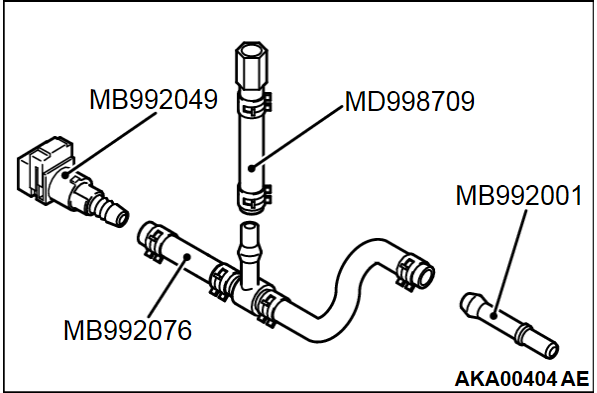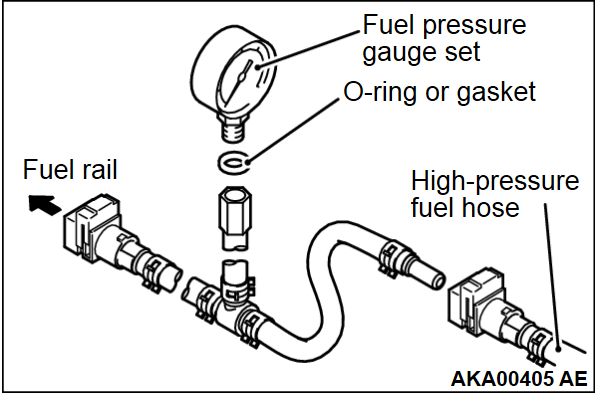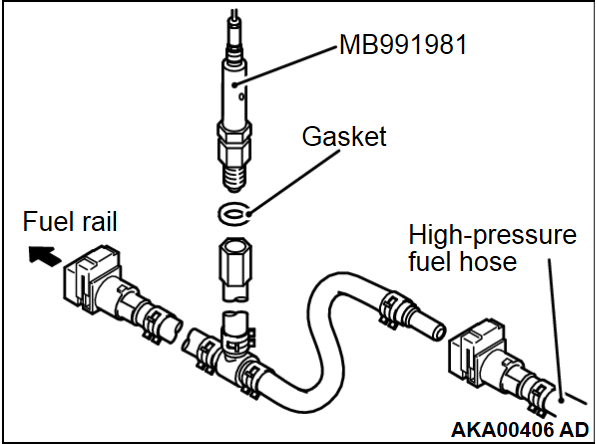FUEL PRESSURE TEST
Required Special Tools:
- MB992744: Vehicle communication interface-Lite (V.C.I.-Lite)
- MB992745: V.C.I.-Lite main harness A
- MB992747: V.C.I.-Lite USB cable short
- MB992748: V.C.I.-Lite USB cable long
- MB991958: Scan Tool (M.U.T.-III Sub Assembly)
- MB991824: Vehicles Communication Interface (V.C.I.)
- MB991827: M.U.T.-III USB Cable
- MB991910: M.U.T.-III Main Harness A (Vehicles with CAN communication system)
- MB991981: Fuel Pressure Gauge Set
- MB992001: Hose Adapter
- MB992049: Quick Connector
- MB992076: Injector Test Set
- MD998709: Hose Adapter
2.
Disconnect the fuel high-pressure hose at the fuel rail side.
| warning | To prevent a fire, cover the hose connection with shop towels to prevent splashing of fuel that could be caused by some residual pressure in the fuel pipe line. |
3. Assemble the special tool MB992076 (injector test set) as shown in figure according to the following procedure.
(1) Remove the injector installation adapter from the hose. Remove another hose together with the adapter and remove the adapter from the remaining hose.
(2) Install the special tool MB992049 (quick connector) and the special tool MB992001 (hose adapter) to the hose without the adapter.
(3) Remove the nipple of the bolt of the special tool MD998709 (hose adapter).
(4) Install the special tool prepared in the procedure (3) to the nipple that was removed together with hose in the procedure (1).
4. Install the special tool assembled in Step 3 between the fuel rail and the fuel high-pressure hose.
<When using the fuel pressure gauge>
- Via a suitable O-ring or gasket, install the fuel pressure gauge to the special tool that has already assembled as described.
<When using the special tool MB991981 (fuel pressure gauge set)>
- Via a gasket, install the special tool MB991981 (fuel pressure gauge set) into the special tool that has already assembled as described.
- Connect the leads from the fuel pressure gauge set to the power supply (cigarette lighter socket) and special tool MB991824 (V.C.I) or a voltmeter.
| caution | To prevent damage to scan tool (M.U.T.-III), always turn the ignition switch to the "LOCK" (OFF) position before connecting or disconnecting scan tool (M.U.T-III). |
6. Turn the ignition switch to the ON position (but do not start the engine).
7. Use Actuator test "item number 9" to drive the fuel pump. Check that there is no fuel leaking from any section when the fuel pump is operating.
8. Finish the actuator test or turn the ignition switch to the LOCK (OFF) position.
9. Start the engine and run at idle.
10. Measure fuel pressure with the engine at idle, and convert the measurement value with the formula below.
<When the scan tool (M.U.T.-III) is used>
- Fuel pressure measurement value [kPa (psi)] × 1.02 kPa (psi)
<When the voltmeter is used>
- [voltage measurement value (V) - 1] × 125 kPa (psi)
Standard value: Approximately 324 kPa (47 psi) at curb idle
11. Check to see that fuel pressure at idle does not drop even after the engine has been revved several times.
12. If any of fuel pressure measured in Step 10 to 11 is out of specification, troubleshoot and repair according to the table below.
| SYMPTOM | PROBABLE CAUSE | REMEDY |
| Clogged fuel filter | Replace fuel filter |
| Fuel leaking to return side due to poor fuel regulator valve seating or settled spring | Replace fuel pressure regulator (integrated in the fuel tank pump module) | |
| Low fuel pump delivery pressure | Replace fuel pump | |
| Fuel pressure too high | Binding valve in fuel pressure regulator | Replace fuel pressure regulator (integrated in the fuel tank pump module) |
13. Stop the engine and observe fuel pressure gauge reading. It is normal if the reading does not drop within two minutes. If it does, observe the rate of drop and troubleshoot and repair according to the table below. Start, then stop the engine.
| SYMPTOM | PROBABLE CAUSE | REMEDY |
| Fuel pressure drops gradually after engine is stopped | Leaky injector | Replace injector |
| Leaky fuel regulator valve seat | Replace fuel pressure regulator (integrated in the fuel tank pump module) | |
| Fuel pressure drops sharply immediately after engine is stopped | Check valve in fuel pump is held open | Replace fuel pump |
15.
| warning | To prevent a fire, cover the hose connection with shop towels to prevent splash of fuel that could be caused by some residual pressure in the fuel pipe line. |
Remove the fuel pressure gauge and special tool from the fuel rail.
16. Fit the fuel high-pressure hose to the fuel rail.
17. Check for fuel leaks.
(1) Use scan tool (M.U.T.-III) to operate the fuel pump.
(2) Check the fuel line for leaks and repair as needed.
18. Disconnect scan tool (M.U.T.-III).
![[Previous]](../../../buttons/fprev.png)
![[Next]](../../../buttons/fnext.png)




